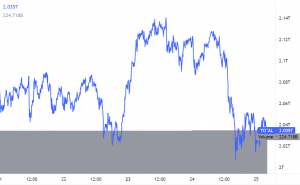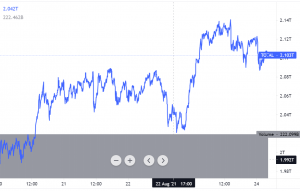
Ethereum Blockchain Solutions for Enterprise Business: Pros and Cons
Ethereum currently is known as the most popular public blockchain network for the development of decentralized applications (DApps) and smart contracts. Its prospective blockchain protocol is one of the few cryptocurrency projects actually achieving real-world adoption, with dozens of applications that can be divided into 11 major categories: open finance, decentralized exchanges, gaming, collectibles, marketplaces, developer tools, identity, governance, infrastructure, token-curated registries and Ethereum Request for Comments (ERC) token standards. Thus, it appears to be leading the field of enterprise blockchain solutions.
Ethereum is contributing to the revolutionizing of the internet with the creation of the Decentralized Web — or Web3 — that facilitates peer-to-peer (P2P) transactions (i.e., without a middleman). It means that Ethereum’s blockchain technology is gradually changing the internet’s P2P economy through a means of control over the technologies and applications that we use extensively.
There are three primary ways Ethereum is doing this: The first is by making money (cryptocurrency) a native feature of the internet; the second is by decentralizing applications to offer users new capabilities, for example, user-driven contribution to Open Government Data; and third is by giving users control over their data and digital identities.
Real-world Ethereum adoption
Out of the 2,000+ cryptocurrencies out there, Ethereum has demonstrated how a blockchain technology can achieve real-world adoption with both individuals and enterprise businesses.
Since Ethereum’s inception in 2015, there have been over 2,500 DApps built on the Ethereum blockchain.
At the forefront of Ethereum enterprise adoption is the Enterprise Ethereum Alliance, a blockchain consortium with over 450 enterprise business members, including Microsoft, JPMorgan Chase, Santander, Accenture, ING, Intel, Cisco and others.
Enterprises implementing Ethereum’s blockchain technology
Microsoft and Amazon have started using Ethereum’s protocol to enable users to create and manage blockchains through their cloud computing blockchain-as-a-service (BaaS) platforms — i.e., Microsoft Azure in May 2019 and Amazon Managed Blockchain earlier in April respectively.
These BaaS platforms could contribute to Ethereum’s growth and adoption. Additionally, they also provide access to Ethereum variants such as JPMorgan’s Quorum blockchain, which is an enterprise-focused, open-source blockchain platform based on Ethereum.
The Quorum blockchain has been exposed to more than 250 global banks so far through Quorum’s Interbank Information Network (IIN) and is now usable by a larger universe of firms through BaaS platforms.
While JPMorgan’s Quorum blockchain is a private or permissioned version of Ethereum, major developments are taking place on the public Ethereum blockchain as well. For instance, Big Four accounting firm, Ernst & Young (EY) recently released a public blockchain protocol called Nightfall. This protocol is a privacy tool based on the zk-SNARKs protocol that enables large corporates and enterprises that require blockchain privacy to build upon the public Ethereum network.
Why large corporations and enterprises choose Ethereum
Ethereum appears to be the leading blockchain among enterprises. For instance, more than 50% of the billion-dollar firms included in Forbes’ “Blockchain 50: Billion Dollar Babies” list are building applications on top of Ethereum or deriving platforms from it.
Here are some of the primary reasons these enterprises are choosing Ethereum:
-
First mover advantage: Ethereum is the first programmable blockchain that features a Turing-complete language on its blockchain that features smart contract functionality.
-
It’s a well-planned project: The majority of cryptocurrencies are quite spontaneous, appearing and dying quickly. Ethereum, on the other hand, is a project with a high level of credibility based on its lasting history — in comparison to other crypto projects — with its white paper released in 2013 and its launch in 2015.
The project has a clear roadmap and vision for its scaling in order to make its blockchain technologically relevant for years to come. The project will scale with the release of Ethereum 2.0, which is a major upgrade being released in four phases over the next two-three years.
-
It’s an open system: Ethereum’s public blockchain is an open system, meaning that anyone can join the project and contribute to its growth and development. This is a major advantage because it makes it possible for anyone to develop the ecosystem and improve it. Closed or private blockchain platforms like Hyperledger, Hashgraph, Corda, etc., do not garner the same network effect as open systems like Ethereum.
-
It has massive support: Ethereum has the largest community of developers working on its blockchain protocol. Hundreds of thousands of developers are working on the Ethereum ecosystem, and the project is backed by both medium-sized companies and large corporations. Also, the Ethereum Enterprise Alliance and Hyperledger monitor and contribute to the development of the project continually.
-
Private transactions: Enterprises can achieve privacy with Ethereum by forming private consortia with private transaction layers, and JPMorgan’s Quorum would be a good example of that. Also, enterprises can now achieve privacy on the public Ethereum blockchain with Ernst & Young’s Nightfall protocol.
-
Rapid deployment: It’s easy for developers and enterprises to get started with Ethereum. All-in-one BaaS platforms like Microsoft Azure and Amazon Managed Blockchain services and software-as-a-service (SaaS) platforms like ConsenSys-backed Kaleido attempt to make it easy for businesses to develop their own blockchain networks. New tools and development kits are continuously being released so that Ethereum can easily be adopted among enterprises and businesses.
-
Interoperability: Enterprises can develop Ethereum-based private/permissioned blockchain networks and plug them into the public Ethereum mainnet to enjoy the vast, active, high-value public blockchain and all the parts of its ecosystem. An example of this is Pantheon from PegaSys, which is Ethereum’s first enterprise client that is compatible with the public chain. All in all, Ethereum’s interoperability essentially keeps enterprise blockchains up to date, as it offers them global reach, an expansive network of users and DApps, and continuous developments and upgrades.
-
Investment: The price of Ethereum’s native cryptocurrency, Ether, has increased by over 9,000% from the time of its launch. Early adopters and investors have benefitted from an exceptional return on investment and ETH prices are expected to continuously increase throughout time.

Ethereum 4-years price chart. Courtesy of Coin360
Fueling an increasing ETH price is the adoption of the Ethereum protocol, new tokenomics — such as staking, which essentially pays stakers dividends, as well as reduced ETH issuance by 10x by 2021. For these reasons, Ethereum is expected to net large conglomerates, enterprises and investors massive returns on investment.
Drawbacks of Ethereum for enterprise
While Ethereum may be the front-running blockchain for enterprise business solutions, it isn’t the be-all and end-all solution, there are some drawbacks. Some of the biggest concerns from enterprise businesses for Ethereum include:
-
Scalability: The primary problem with Ethereum is scalability. Transactions are still very slow, as Ethereum’s public blockchain can only process roughly 15-20 transactions per second (TPS) compared to the 45,000 processed by Visa. Enterprises require a very high throughput of transactions, and Ethereum can not yet offer that on its public mainnet.

Source: Cointelegraph Analytics
However, permissioned variants of the Ethereum blockchain do not suffer the same constraints as public Ethereum and can transact much faster than 15-20 TPS. Therefore, Ethereum has somewhat solved this problem for now, as Enterprises can develop these private Ethereum blockchains and bridge them to the public Ethereum blockchain when it’s able to scale. Earlier this month, Ethereum co-founder Vitalik Buterin suggested to use Bitcoin Cash blockchain as a temporal solution that would help solve the scalability problems of the Ethereum network.
-
Uncertainty: Another major drawback to Ethereum for enterprise is that the project is still being heavily developed, and there can be some breakdowns in the system along the way. For instance, in order for Ethereum to scale, it must transition from a proof-of-work (PoW) to a proof-of-stake (PoS) consensus algorithm in the Ethereum 2.0 upgrade. This is a very serious change — and if it doesn’t go smoothly, the whole system can crash.
-
Competition: While Ethereum is leading the way in enterprise blockchain adoption, it is competing with other blockchain protocols that claim to be more scalable than Ethereum. Such competitors include EOS, Cardano, Stellar, Neo, TRON, and others. As well, Ethereum will be competing with new blockchain protocols that haven’t even launched yet, such as Hedera Hashgraph, Polkadot and Telegram Open Network (TON) .
Ethereum 2.0: How will it change enterprise interaction with the ecosystem
Ethereum currently suffers from a number of problems and limitations surrounding its blockchain technology, including problems with interoperability, economic and transactional scalability, security, stability, governance and more. However, the team behind Ethereum is addressing these issues with a radical overhaul of the protocol through the Ethereum 2.0 upgrade.
As put by Buterin:
“Ethereum 1.0 is a couple of people’s scrappy attempt to build the world computer; Ethereum 2.0 will actually be the world computer.”
To make Ethereum “the world computer,” the upgrade will introduce three primary components that are poised to help the protocol succeed and be adopted as the standard among businesses:
-
A switch from the energy-intensive PoW consensus algorithm to a PoS consensus algorithm. Ethereum holders will be able to stake with a minimum of 32 ETH or can pool their ETH together. This will enable more participants to join the network, making Ethereum 2.0 more decentralized, resilient and secure.
-
Implementation of network-wide, second-layer scaling solutions such as sharding, which will allow Ethereum transactions on a parallel subchain. This scaling solution will be combined with Plasma chains and will enable Ethereum to handle a higher volume of transactions — “many tens of thousands of decentralized transactions per second,” according to Ethereum co-founder Joseph Lubin.
-
The Ethereum Virtual Machine (EVM) — which is the engine responsible for the deployment of DApps on the blockchain — will be completely revamped and run on a new programming code called WebAssembly (WASM). This part of the upgrade will increase Ethereum’s overall speed, usability and security.
Moreover, Ethereum 2.0 is being delivered over seven distinct phases and the first three phases — Phase 0 – Beacon Chain, Phase 1–Basic Sharding and Phase 2 –eWASM — are slated to take at least a year and a half before implementation is complete, and it is expected to be launched at the beginning of 2020. This simply means that Ethereum 2.0’s delivery is going to take a long time, and we can expect to see delays along the way, just as it was with Ethereum’s major Constantinople hard fork that saw multiple delays and was quite hard to implement.
Being one of the oldest players on the crypto field, Ethereum has gained a trusted credibility among enterprise businesses. Also, its protocol’s real-world applications has covered 11 major categories that enterprise businesses could potentially be interested in. And Ethereum’s large community of developers, which works on the blockchain’s protocol improvements, could be considered by enterprise businesses as a technological benefit. Meanwhile, Ethereum constantly faces update delays, a low level of scalability and burgeoning competitors.
All in all, Ethereum could easily be replaced by a competing blockchain protocol that’s able to deliver on its promises and expand its blockchain network faster. After all, it is still very early in this innovative world of blockchain technology and there are no clear winners just yet.
Do you think Ethereum will continue to be the leading blockchain for enterprise blockchain solutions or will another project come along and prove to be better? Let us know what you think in the comment section below.
The views, thoughts and opinions expressed here are the authors alone and do not necessarily reflect or represent the views and opinions of Cointelegraph.
ABOUT THE AUTHOR: Jeremy Wall is a financial writer and aspiring investor. He is also a cryptocurrency enthusiast who’s fascinated with blockchain technology and the financial markets. When he’s not researching and learning about cryptocurrency, he’s traveling the world with his dog and girlfriend.
Source: cointelegraph.com
View original post





